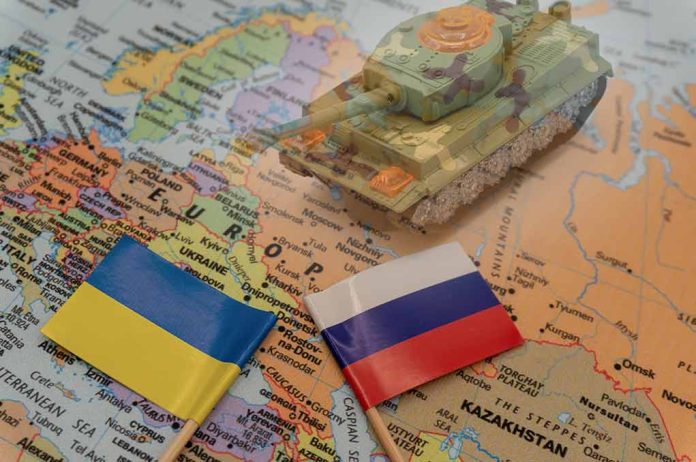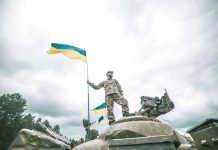
Russia unleashes massive retaliatory strike on Ukraine with hundreds of missiles and drones, killing multiple civilians while claiming to target only military sites in response to what Moscow calls “terrorist acts by the Kyiv regime.”
Key Takeaways
- Russia launched a coordinated assault with hundreds of missiles and drones across multiple Ukrainian cities, causing civilian casualties and infrastructure damage.
- Moscow claims the strikes were precision-targeted at military facilities in direct response to Ukraine’s recent drone attacks on Russian bomber planes.
- President Trump suggested letting the warring nations “fight for a while” before seeking peace, highlighting his pragmatic approach to the conflict.
- North Korean leader Kim Jong-un has pledged “unconditional support” to Russia, indicating a troubling alliance forming against Western interests.
- Peace talks in Istanbul recently ended without progress as Russia rejected calls for an unconditional ceasefire.
Massive Russian Strike Claims Multiple Civilian Lives
Russia launched a devastating combined missile and drone attack across Ukraine, targeting Kyiv and other major cities in what appears to be Putin’s promised retaliation for Ukraine’s recent strikes on Russian airbases. The assault involved hundreds of projectiles including cruise and ballistic missiles, resulting in multiple civilian deaths and injuries. In Kyiv, explosions triggered fires in a 16-story residential building and a metal warehouse, while authorities reported damage to metro infrastructure and ongoing rescue operations throughout the capital city.
The western city of Ternopil suffered what local officials called its “most massive air attack to date,” with extensive damage to homes, schools, and government facilities. In Lutsk, Russian forces struck with 15 drones and six missiles, injuring at least five people. The scale of these attacks represents a significant escalation in the conflict, following a late May assault that killed at least 12 Ukrainians. Russian forces appear to be intensifying their campaign despite international condemnation.
🚨 BREAKING: Following today’s large-scale FPV drone strikes on four Russian airbases, Russian war bloggers are urging missile retaliation using the Oreshnik IRBM.
🔸 Hypersonic, Mach 10
🔸 Range: 3,000–5,000 km
🔸 Carries 6 warheads, each with submunitions
🔸 Nuclear or… https://t.co/0houJI6kcX pic.twitter.com/mBuIqOLLkn— Defence Index (@Defence_Index) June 1, 2025
Russia Claims Legitimate Military Targets
Moscow insists its attacks were precisely aimed at military targets rather than civilian infrastructure. “In response to terrorist acts by the Kyiv regime, the Russian armed forces overnight launched a massive strike with high-precision long-range air-, sea- and ground-based weapons, as well as attack drones,” stated Moscow’s defence ministry. Russian officials further claimed they had successfully shot down 174 Ukrainian drones and intercepted Neptune missiles over the Black Sea, portraying their actions as defensive responses to Ukrainian aggression.
“Sometimes you’re better off letting them fight for a while and then pulling them apart,” said President Donald Trump, comparing the conflict to “two young children fighting like crazy in a park.” according to The Guardian
The Russian attack followed Putin’s promise of retaliation after a covert Ukrainian operation destroyed several Russian strategic bomber planes at airbases inside Russia. Ukraine has continued its strategy of hitting Russian military infrastructure while avoiding direct confirmation of specific operations. This exchange of strikes highlights the increasingly direct confrontation between the two nations, with neither showing signs of backing down despite the mounting civilian toll.
International Reaction and Concerning Alliances
President Volodymyr Zelenskyy has called for increased international pressure on Russia to end the conflict. “Now is the moment when America, Europe and everyone in the world together can stop this war by putting pressure on Russia. If someone does not put pressure and allows the war more time to take lives, this is complicity and responsibility,” stated Ukrainian President Volodymyr Zelenskyy.
In a troubling development for Western interests, North Korean leader Kim Jong-un has pledged to “unconditionally support” Russia in the conflict during a meeting with Russian security official Sergei Shoigu. This alliance between nuclear-armed states signals a growing anti-Western bloc that complicates diplomatic efforts to resolve the Ukraine conflict. Meanwhile, recent peace talks in Istanbul concluded without progress after Russia rejected proposals for an unconditional ceasefire, suggesting that diplomatic solutions remain distant.
Nuclear Concerns Amid Escalating Conflict
The International Atomic Energy Agency reported gunfire at the Zaporizhzhia nuclear plant, likely targeting drones, though no immediate damage was reported. This incident underscores the persistent danger of nuclear catastrophe as combat operations continue near critical infrastructure. The Zaporizhzhia plant remains a flashpoint in the conflict, with both sides accusing each other of reckless behavior that could trigger a radiation disaster affecting much of Europe.
“The world order,” is at stake according to one U.S. official familiar with the conflict’s broader implications.
As President Trump has accurately noted, Russia is responding with significant force to Ukraine’s strategic strikes. The reality on the ground reflects Trump’s pragmatic assessment that this conflict may need to run its course before meaningful peace can be achieved. With North Korea openly supporting Russia and peace talks stalled, the Ukraine war appears set to continue with increasingly dangerous consequences for regional stability and civilian populations caught in the crossfire.







